Computer Telephony Overview
Understanding Configurations, Terminology, and Shopping for a New Telephone SystemOver 15 years ago competition in the telecom industry along with technological advancements changed how we do business. The telecom and computer industries converged. This computer/telephony overview will explain how telephone service was delivered in the past, and how the telephone and computer industries have converged today. This overview is helpful to understand common configurations and terminology that is used when shopping for telecom and data services, and a new telephone system.
Telephone service was delivered as POTS lines, or “Plain Old Telephone Service” for more than 100 years. Historically, each community had one local phone company. The local phone company would connect to the public switched telephone network or PSTN. Connectivity to a customer’s premise was (and still is today) a pair of copper wires that connects a customer’s home or building to the local phone company. POTS lines are analog, and are sometimes called “copper lines from the street”.
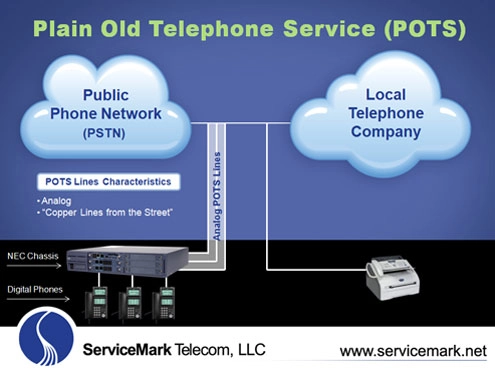
In this illustration there are three POTS lines connected to a business phone system which provides the ability for three simultaneous phone calls.
POTS lines are also commonly used for fax machines.
Competition and advancements in technology has provided more ways to connect phone service to homes and buildings. Its common place today to use VoIP technology to deliver service that is converted to Plain Old Telephone Service (or POTS lines).
Today, customers have more than one choice for local phone service. A number of providers deliver telephone service via T1’s or Fiber which provide dedicated bandwidth between a customer’s premise and a local phone company. T1’s and Fiber are both considered best practices and are very reliable. Cable TV companies also deliver telephone service over a coax cable. Quality of phone conversations over coax cable can vary because the bandwidth is not dedicated bandwidth and is shared with your neighbors. When others in your neighborhood get busy on the internet the quality of phone service can suffer.
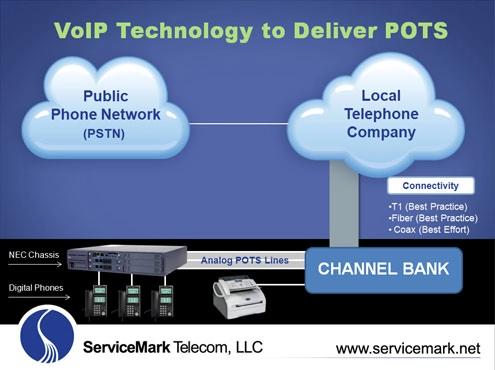
In this illustration, a channel bank converts IP data packets to Plain Old Telephone Service or POTS lines.
Although Plain Old Telephone Service sounds old fashion and unexciting, it still fits for a small business with one location that is only concerned with one main phone number. And POTS lines are still used for fax machines.
POTS lines have their limitations.
• Plain Old Telephone Service does not support Direct Inward Dialing, or private phone numbers that ring directly to office telephones
• POTS don’t support a mobile extension feature which provides office phone functionality through mobile phones
• POTS lines don’t support quality conference calls of more than two outside parties
• And POTS lines don’t provide a viable solution for a centralized telephone system that services multiple locations
For many small offices, and for most businesses with more than 10 employees, telephone and internet service is delivered over a common connection, and telephone service is delivered via a Primary Rate Interface or PRI.
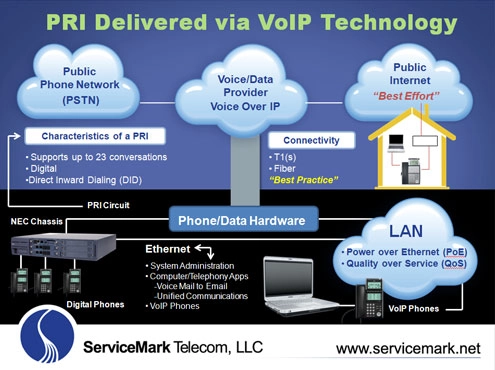
This illustration provides three examples of VoIP technology. Two of the examples are best practices and come with a guarantee.
One example is “Best Effort” and not guaranteed. Businesses today have a variety of choices for telephone and internet service. Its commonplace that a voice and data provider will provide connectivity to the Public Switched Telephone Network (or PSTN) and the Public Internet. Phone and internet service can be delivered via T1s or a Fiber Optic cable, both are very reliable and are considered best practices. The Voice and Data Provider installs Phone and Data Hardware at the customer’s premise which provides connectivity to a phone system and the customer’s Local Area Network (or on premise data network).
Commonly, the physical connection to the phone system is a Primary Rate Interface, or PRI Circuit. Characteristics of a PRI include:
• The ability for up to 23 simultaneous conversations
• It’s a digital connection
• And PRIs provide Direct Inward Dialing commonly abbreviated as DIDs which provides the ability for every business telephone to have a direct dial number.
• Using a common connection for voice and data service is made possible through VoIP technology. This example is talking over a private data network and not the public internet. This is an illustration of a best practice that should be very reliable.
For all phone system installations, ServiceMark will connect the telephone system to a customer’s local area network, and the phone system becomes a part of the data network.
• This provides for easy system administration through an intuitive point and click web browser interface.
• This connection provides the ability for computer/telephony applications.
• For an example, voice mail messages can appear as emails. Users can easily see the name and telephone number in the email subject line and click on an audio attachment to listen to a voice mail message from a computer or smart phone.
• Unified Communications is software that appears on a computer that interacts with the business telephone system. Unified Communications works like a Smartphone from your desktop computer which provides an improved end user experience and provides productive collaboration between employees. Capabilities such as click to dial, drag and drop phone calls, presence, quick message, IM or instant message for employees working in or out of the office is now commonplace and affordable for most businesses.
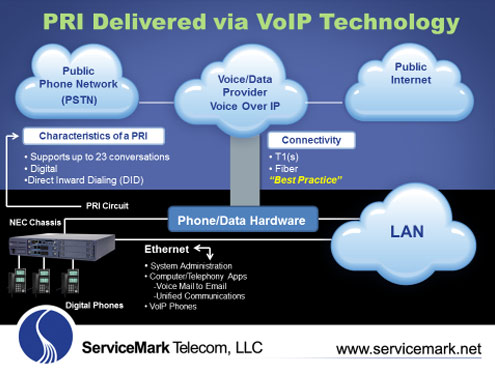
The telephones shown in this diagram are an illustration of digital phones that connect directly to the NEC Chassis (or telephone system) via wires and jacks that are separate from the data network.
• Since the telephone system connects to the data network, it is possible to deploy VoIP telephones. If data switches are equipped with Power over Ethernet, and Quality of Service to insure quality phone conversations, a single data cable and jack can provide connectivity to a phone and computer.
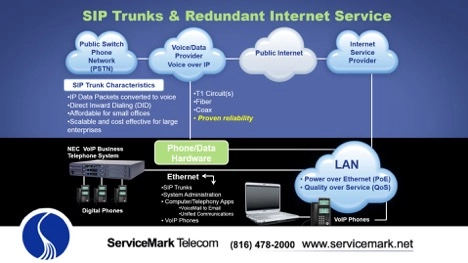
Deploying digital phones and VoIP phones are both common place, and a more in depth conversation with a ServiceMark representative can help determine which configuration is best and most cost effective for you.
• Because of VoIP technology, it is now possible to have office phones connected off premise using the public internet. These office phones can be desk phones or softphones or software that resides in the user’s computer. It’s important to note that the public internet is a best effort connection and the quality of voice conversations is not guaranteed.
Advantages of this illustration are as follows:
• The connectivity via T1s or Fiber is very stable and considered best practice.
• Direct Inward Dialing or DID numbers allow each user to have their own direct dial phone number
• The configuration supports mobile extension which extends office phone functionality to mobile phones
• Conference calls sound great!
• VoIP phones can be deployed on or off premise
Because of VoIP technology, businesses can deploy one phone system that serves multiple offices. A voice and data provider can provide connectivity to a customer’s corporate office and branch offices through a private MPLS IP network which is reliable, guaranteed, and is a best practice.

A more detailed discussion with a ServiceMark Representative will help determine the best configuration of telephone and data services and products for your business. Please contact us at 816-478-2000 or support at ServiceMark.net for a no cost consultation.
